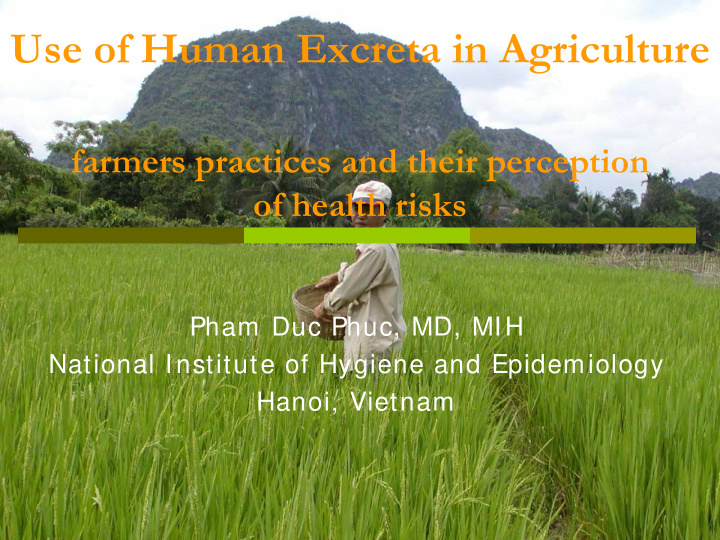



Use of Human Excreta in Agriculture farmers practices and their perception of health risks Pham Duc Phuc, MD, MIH National Institute of Hygiene and Epidemiology Hanoi, Vietnam
Introduction � Applying human excreta to agricultural fields has been a long time ago in VN. � Despite the potential health risk, the practice is still wide spread. � 85% farming households had used latrine wastes as fertilizer (Phuc et al. 2005) � In agriculture: Human excreta are � It is cheap fertilizers � Good for soil structures � Reduced imported chemical fertilizers � Nutrition recycling in different types of integrated farming systems
Objectives � To describe the current use and handling of human excreta as fertilizer � The farmers’ perceptions of health risks and hygiene related to the use of latrine waste as fertilizer � The study findings are discussed in relation to the new guidelines for use of human excreta in agriculture.
Methodology � Study areas: 5 communes in Nghe an � Total 471 hhs were selected � The Respondents: head of hhs or adult people � Key persons: Communal people’s committee, women’s union, farmer’s association and health station.
Methodology � Questionnaires � Participate observations � Key informant interviews � Focus group discussions � In-depth interviews
Findings 1. Latrine types 2. Farmer’s practices 3. Annual frequency 4. Farmer’s perception
Latrine types � 56% hhs used a Double vault Composting (DVC), � 35% hhs used a Single Vault (SV), � 5% used a temporary (shallow hole/ pit), � 4% used a septic tank/ pour flush.
Farmer’s practices � 92% hhs used of Human excreta (HE) as fertilizer � 94% hhs compost HE before used � 50% hhs storage HE inside the latrine � 8% hhs storage HE both inside and outside the latrine � 38% hhs storage HE outside the latrine
Farmer’s practices � All 471 hhs put kitchen ash into the latrine vault after each defecation. � 63% hhs added lime to the latrine � 24% after each visit, � 45% weekly, � 31% monthly or less frequently � 99% hhs composting HE outside the latrine added kitchen ash, and 55% hhs added also lime,
Human excreta used for annual crop of the year � 78% hhs applied composted HE for rice is first crop (December- January) � 41% hhs applied composted HE for rice is second crop (May-June) � 72% hhs applied composted HE for corn, potatoes are third crop (August-September)
Annual frequency of human excreta application on crops 4 months 41% 78% December May (first rice crop) (second rice crop) 4 months 4 months 72% September (corn, potatoes,… crop)
Annual frequency of human excreta application on crops Human excreta used as fertilizer for Number of Percentages hhs Only first crop in January 35 7% Only second crop in June 3 0.6% Only third crop in September 74 16% Both first and second crop (January and 80 17% June) Both first and third crop (January and 156 33% September) Both second and third crop in June and 21 5% September All 3 crops 90 19% At least 1 crop per year 459 98% At least 2 crops per year 347 74% Only 2 crops per year 257 57%
Farmer’s perception � Composting done to achieve hygienic product and improve fertilizer product but depends upon type of latrine available � Human excreta regarded the ”dirtiest” fertilizer due to bad smell but praised for its nutritious values � Human excreta and chemical fertilizer compared to eastern and western medicine
Farmer’s perception � Perceived risk clearly associated with smell, secondly texture, thirdly color � Protective practices given minimal attention and then only when handling excreta with smell � Other peoples waste and smell from others excreta regarded a health risk
Protecting the “inside” � Nghe An-farmers - sometimes wear mask and boots when handling fresh excreta � In the fields few wear any protection since excreta does not smell � Women used more protective measures but seen as reducing work output � Women seen as more vulnerable
Summary � Health risk perception � 74% hhs at least once per associated with smell year will have only 3-4 months available for � Diseases enters through composting excreta mouth or nose � They not meet the new � Unpractical protective Vietnamese guidelines measures � Kitchen ash or lime are � Cleanliness is about clean moisture absorption appearance/ visible dirt � Production given first priority above hygiene � Organic waste seen as valubal input to production � Large degree of gender difference in exposure and use of protective measures
Recommendations � Change latrine type to a non-reuse system; � Only use human excreta as fertilizer for every second crop or only once per year, � Use additives that increase pH to obtain a more rapid pathogen die-off inside the vault.
Acknowledgement � Local institutions and farmers in the study area � The Water Sector Program in Nghe An province. � Danish International Development Assistance (DANIDA) through project number 91177 � The International Foundation of Science (IFS) project number W/ 3682-1
Thank you for your attention
Recommend
More recommend